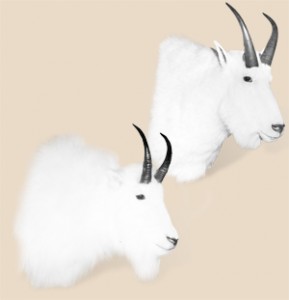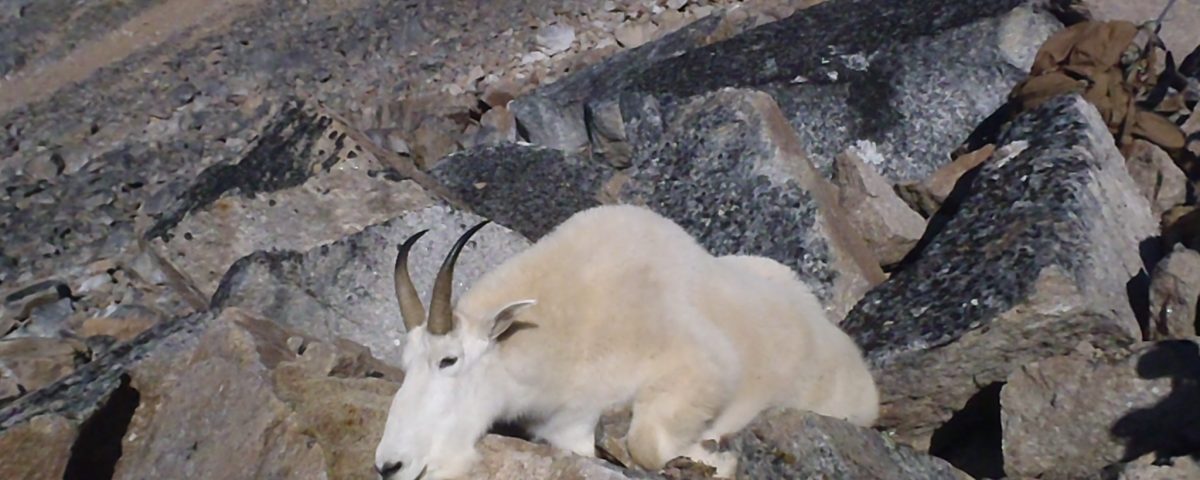
Gear Pack List for Your Hunt
July 23, 2019
Best Alberta Whitetail Hunting Outfitter
October 19, 2019From Boone and Crockett Club:
 “It would be hard not to classify any mature Rocky Mountain goat as a trophy considering all that goes into a successful hunt for these cliff dwellers. Nevertheless, as with all antlered and horned big game species, there are certain visual indicators that translate to Boone and Crockett score that are valuable tools in judging size of horn in the field.
“It would be hard not to classify any mature Rocky Mountain goat as a trophy considering all that goes into a successful hunt for these cliff dwellers. Nevertheless, as with all antlered and horned big game species, there are certain visual indicators that translate to Boone and Crockett score that are valuable tools in judging size of horn in the field.
Accurately field-judging mountain goats has a unique set of challenges. Â For one, both males and females have horns or antler. The only other North American big game species to regularly exhibit this characteristic are pronghorn, sheep and caribou. In these instances female horn or antler growth is significantly smaller, and therefore this feature alone makes identifying sex in the field rather easy.
For mountain goats this is not the case, in fact many wildlife departments allow the taking of nannies purely due to the difficulty of ascertaining the correct sex quickly in the field. They encourage hunters to avoid nannies and in many cases require an orientation course on identifying billies and yet nannies are still mistakenly taken. The key to making this determination and evaluating a goat lies in mass of both horns and body. Nannies rarely grow the mass needed to make B&C minimums (47 Awards, 50 All-time book). The mature billy will exhibit a definitive hump on his back or shoulder and will overall appear “thicker” than a nanny. The horns of a billy will curl over their entire length while a nannies horns will commonly rise straight up, only curling back on the upper 1/3 or 1/4 of the horn.
Another factor to keep in mind is that normally a trophy goat will be a loner. This creates a special challenge for field judging since outside of the rutting season (late November), one seldom sees a mature billy other than alone or as one of a small group. Since a loner is not necessarily always a big mature billy, an assessment of his size, bulk, apparent horn length and mass is essential to proper identification of a high scoring trophy though there is usually not a medium or small billy close by for comparison.
The length of each horn is factored into the final score, so lets start there. When estimating horn length we must take into consideration two factors. One is that horn, especially on males, will grow in a curved, backward configuration and depending on the time of year hunted, long winter coats can hide horn growth at the bases near the skull.
The curvature of the horn can short change the true length of horns in field observations, so it is a good idea to try and visualize the horns as straight. If the apparent horn length is visualized as straightened-out, and it reaches the distance from the nostrils to the bottom of the eye, you are looking at a horn length of probably at least eight, but not over nine inches. If the same comparison yields an apparent length equivalent to the distance from the nostrils to the ear hole, you are unquestionably looking at a records-class billy, providing his horn tips are not broken and he appears to have a thick base on each horn.
Another useful gauge is the apparent length of the horns compared to the visible length of the ear. For trophy quality, one normally must look for a horn that appears to be two and one-half times the visible length of the ear.
Judging the base of a billy goat’s horns is a fine art. Though a general rule to use is that when viewed straight on the bases will appear to nearly touch, on a nanny or lesser billy white will be definitively visible. Be cautious though since billy’s possess two large black glands directly behind the horns which can be mistaken for extraordinary mass. Nannies do not have this gland. A look to the records reveals that the best bases and ultimately the best scoring goats come from the Pacific Coast range, or the west slope of the Rockies, or in the Cassiars. Obviously there are exceptions, but Boone and Crockett record data supports the exceptional bases being more common from Coast Range goats.
Reviewing the top 100 records-book goats of all-time, you will find the base circumferences range from 6 to 6-6/8 with all but ten entries coming from northern coastal locations. The other locations showing up in the top 100 include; Washington, Oregon, Idaho, Utah, Montana, Colorado, and Nevada. The remaining 90 entries are all from costal Alaska and British Columbia.”

